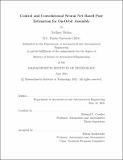Control and Convolutional Neural Net Based Pose Estimation for On-Orbit Assembly
Author(s)
Dolan, Sydney
DownloadThesis PDF (8.963Mb)
Advisor
Crawley, Edward F.
Terms of use
Metadata
Show full item recordAbstract
On-orbit assembly is a critical technology for the future of space exploration, as it will enable larger, adaptive space structures that can support a variety of space exploration needs. The field of on-orbit assembly is still nascent, and few projects exist to technically investigate its feasibility. TESSERAE, or Tessellated Electromagnetic Space Structures for Exploration of Reconfigurable Adaptive Environments, a project out of the MIT Media Lab Space Exploration Initiative, is a multi-year research effort to develop a set of self-assembling, decentralized tiles that use electromagnets to dock with one another and build space structures. Successful early stage technology demonstrations have occurred on both zero-g flights and on the International Space Station, validating the basic premise of operation. Before TESSERAE can be demonstrated in an open orbit environment, an on-board flight computer must be developed to model the dynamics of the system and control its assembly.
This thesis seeks to contribute to the development of on-orbit assembly by contributing a first analysis of multi-unit, agentless control for autonomous self-assembly in orbit. In specific, three areas are investigated: path planning, control for proximity operations, and monocular pose estimation. Path planning for on-orbit assembly is analogous to the traveling salesman problem, as the tiles will have to visit each another once to create the whole structure. As a result, two search algorithms, a greedy algorithm and branch and bound algorithm, are evaluated on their ability to produce a result with minimal ΔV. The branch and bound algorithm has the best performance, as it is an exhaustive search method guaranteed to find the global minimum.
Next, a sliding mode controller is implemented for rendezvous and station-keeping between tiles. The control force is adapted to be realistic for the electromagnetic attraction between tiles. Using electromagnets for control poses a unique challenge due to the nonlinearity of the system dynamics, and of the magnets. The controller was able to drive the tiles to rendezvous, even with the conservative approach to electromagnetic force modeling. These results indicate that TESSERAE tiles will be able to rendezvous with one another even when meters apart.
Finally, this work investigates the potential of convolutional neural network based estimation methods for on-orbit assembly. The pose estimation network is broken into three steps: object detection, landmark regression, and pose estimation. A comparative analysis of several object detection networks, landmark regression approaches, and pose solvers is presented. This work found that bottom-up landmark regression methods are the most suitable for on-orbit assembly, but their accuracy needs to be improved more before implementation. An increase in the size of the training dataset for the convolutional neural network will dramatically improve the results of the pose estimation. Future work will develop additional images, as well as investigate the effects of maintaining the resolution throughout the pipeline to improve the feature detection for pose estimation.
Date issued
2021-06Department
Massachusetts Institute of Technology. Department of Aeronautics and AstronauticsPublisher
Massachusetts Institute of Technology